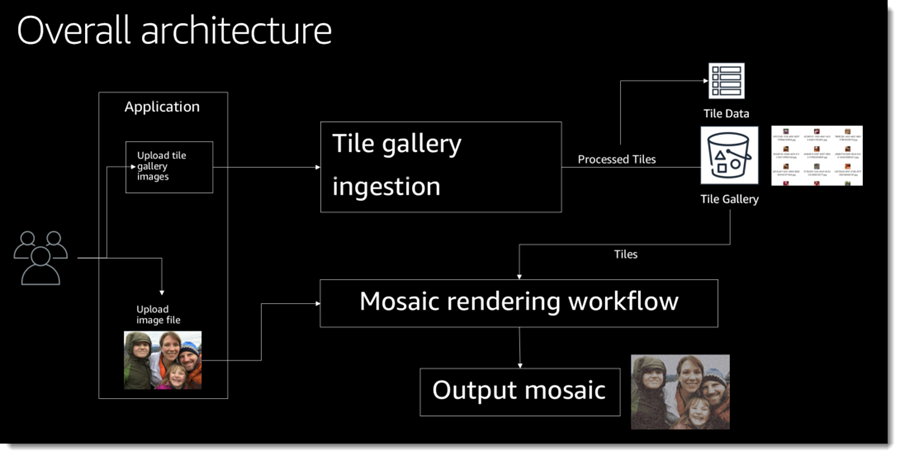This guide presents the CloudMosaic serverless demo application first shown in the AWS re:Invent 2018 session Developing with .NET Core on AWS: What's New. The guide acts as a workshop with the modules and steps to follow to deploy the application in your own account.
Note: the CI/CD content from the original re:Invent session is not currently discussed in this sample but the necessary AWS CodeBuild files have been retained alongside the code assets for reference.
CloudMosaic is an application that enables registered and signed-in users to create mosaicked images. A mosaicked image is one in which blocks of pixels in the original source image are replaced by smaller image tiles, selected from a user-specified tile gallery. Users can upload zip files containing images to be processed and used as tiles in galleries. When a user zooms into a mosaicked image they can see the individual tile images that make up the mosaic.
The sample illustrates modern, serverless, .NET Core applications on AWS. It uses the AWS SDK for .NET to work with AWS services from within application code, as well as tools from AWS to integrate with Visual Studio (on Windows) and the dotnet CLI (on Windows, macOS, and Linux) to make working with serverless application development on AWS easy and convenient.
Following the instructions in this sample you will gain experience in deploying to and using the following AWS services, with the tools you are already familiar with - namely Visual Studio and AWS extensions for the dotnet CLI:
- Amazon Cognito
- Amazon DynamoDB
- AWS Batch
- AWS Fargate
- AWS Lambda
- AWS Step Functions
- AWS Systems Manager
The instructions in this sample can be used by those working on Windows, macOS, or Linux.
The overall architecture of the application is shown below. Individual modules will dive into the architecture of the three primary subsystems (tile gallery ingestion, mosaic rendering workflow, and web front-end).
To perform the steps in this workshop on Windows, macOS, or Linux you will first need to install some tools. Follow the instructions below for your chosen environment, and then proceed to configure those tools with an AWS credential profile], using module 1, enabling you to work with AWS services using the tools.
If you are using Windows as your platform of choice, we recommend you install the following toolchain to make the most of this workshop.
-
Visual Studio 2019 (the free community edition of Visual Studio is sufficient). You can also use Visual Studio 2017 if you wish.
Note 1: The IDE must be installed with the .NET Core, ASP.NET Core and F# workloads.
Note 2: If you are using Windows but do not want to use Visual Studio, you can install the .NET Core SDK (AWS Lambda supports .NET Core 2.1) and use the AWS extensions for the dotnet CLI (see below). -
Note: AWS Lambda supports .NET Core 2.1, so be sure to install the correct SDK version
-
AWS extensions for the dotnet CLI:
-
To install the tools needed for this guide, run the following commands from a command shell
dotnet tool install -g Amazon.Lambda.Tools dotnet tool install -g Amazon.ECS.Tools
-
-
Note 1: Linux-based containers will be used in this guide.
Note 2: After installing, be sure to log out and log back in again so that your user account is correctly updated to work with Docker.
Note 3: If you are using Windows 10 Home, please install Docker Toolbox instead as Docker for Windows is not supported on Windows 10 Home.
-
Note: AWS Lambda supports .NET Core 2.1, so be sure to install the correct SDK version
-
AWS extensions for the dotnet CLI:
-
To install the tools needed for this guide run the commands from a command shell
dotnet tool install -g Amazon.Lambda.Tools dotnet tool install -g Amazon.ECS.Tools
-
The guide consists of a series of modules that you should work through in order to configure and deploy the sample application to AWS. Module 1 is used to set up the AWS tools and user credentials for the remaining modules. If you already have these configured you can skip straight to module 2 to begin the guide.
Important Note: This guide creates chargeable AWS resources. You may wish to remove these resources upon completion of the guide to avoid incurring future charges to your account. To do this, be sure to follow the instructions in Module 7: Resource cleanup.
Follow the modules in order to successfully configure and deploy the sample application to AWS.

